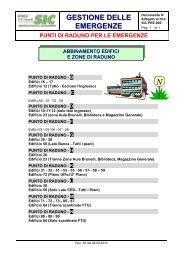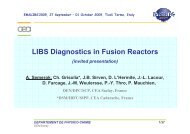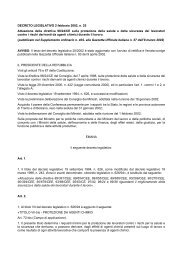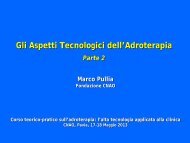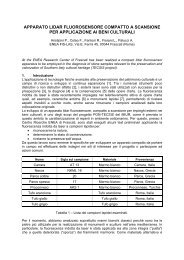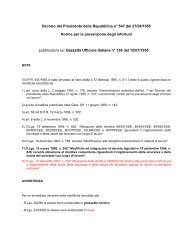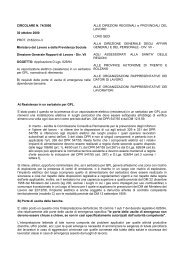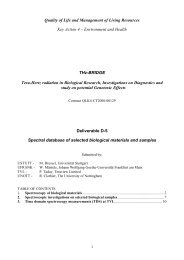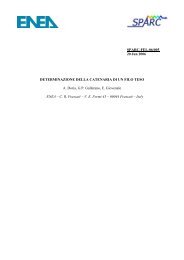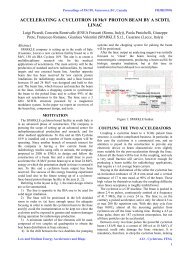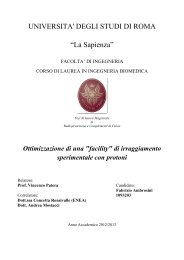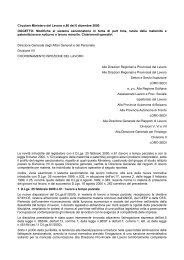Theory, Design and Tests on a Prototype Module of a Compact ...
Theory, Design and Tests on a Prototype Module of a Compact ...
Theory, Design and Tests on a Prototype Module of a Compact ...
You also want an ePaper? Increase the reach of your titles
YUMPU automatically turns print PDFs into web optimized ePapers that Google loves.
1. TRANSMISSION MATRIX REPRESENTATION 51<br />
<str<strong>on</strong>g>and</str<strong>on</strong>g> if it is short-circuited, then<br />
<br />
VN<br />
0 (TN)<br />
= TN =<br />
12<br />
IN<br />
1 (TN) 22<br />
<str<strong>on</strong>g>and</str<strong>on</strong>g> in an analogous way, for the other cavities, it is<br />
<br />
<br />
VN−1<br />
VN<br />
0<br />
= TN−1 = TN−1 · TN =<br />
IN−1<br />
IN<br />
1<br />
<br />
<br />
VN−2<br />
0<br />
= TN−2 · TN−1 · TN =<br />
1<br />
IN−2<br />
(TN−1 · TN)12<br />
(TN−1 · TN)22<br />
(TN−2 · TN−1 · TN)12<br />
(TN−2 · TN−1 · TN)22<br />
<br />
<br />
(4.22)<br />
Last, we can deduce the rule for the generic capacitance<br />
<br />
N<br />
<br />
Vci ∝ Ii =<br />
for i = 1, 2, . . . , N (4.23)<br />
l=i<br />
Tl<br />
22<br />
<str<strong>on</strong>g>and</str<strong>on</strong>g>, <strong>of</strong> course, VcN+1 ∝ 1.<br />
In the expressi<strong>on</strong> (4.23) we need the product <strong>of</strong> N−i+1 transmissi<strong>on</strong><br />
matrix, but remembering the matrix (4.17), we can obtain in a similar<br />
way<br />
⎛<br />
⎞<br />
N ⎜<br />
Tl = ⎝<br />
l=i<br />
<str<strong>on</strong>g>and</str<strong>on</strong>g> therefore<br />
cosh (N − i + 1)x jωM sinh x sinh (N − i + 1)x<br />
−j sinh (N − i + 1)x<br />
ωM sinh x<br />
cosh (N − i + 1)x<br />
Vci ∝ cosh (N − i + 1)x for i = 1, 2, . . . , N<br />
VcN+1 ∝ 1<br />
⎟<br />
⎠<br />
(4.24)<br />
(4.25)<br />
1.5. Asymptotic expressi<strong>on</strong> <strong>of</strong> the ratio between the voltages<br />
<strong>on</strong> the capacitances <strong>of</strong> two adjacent cavities in an infinite<br />
structure. In this short subsecti<strong>on</strong> we c<strong>on</strong>sider an interesting property<br />
<strong>of</strong> an infinite chain <strong>of</strong> cavities, that is given from the ratio <strong>of</strong> the<br />
voltages <strong>of</strong> two adjacent cavities. Let us start from the ratio<br />
Vci<br />
Vci+1<br />
= cosh (N − i + 1)x<br />
cosh (N − i)x<br />
<str<strong>on</strong>g>and</str<strong>on</strong>g> imposing that N − i + 1 = i ′ , <strong>on</strong>e obtains<br />
Vci<br />
Vci+1<br />
=<br />
=<br />
cosh i ′ x<br />
cosh (i ′ − 1)x =<br />
1<br />
cosh x + sinh x tanh i ′ x<br />
cosh i ′ x<br />
cosh i ′ x cosh x + sinh i ′ x sinh x<br />
(4.26)<br />
(4.27)



